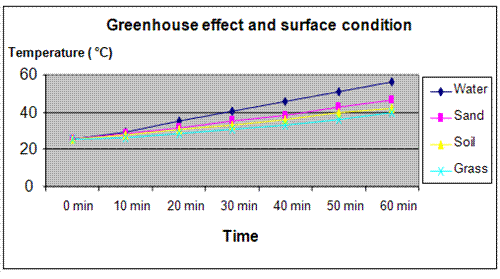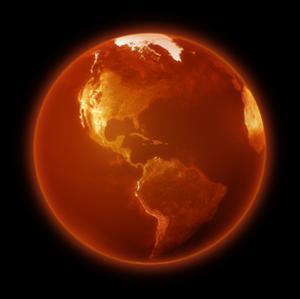| Complexity level: | 7 |
| Project cost ($): | 25 |
| Time required: | 1 hour to prepare, 1 hour for the science project experiment |
| Material availability: | Hobby store and gardening supplies depot |
| Safety concerns: | Adult assistance is required for operation of the drill |
Hypothesis
Carpet grass surfaces have the least amount of increase in temperature due to the greenhouse effect
Overview
Greenhouse effect
Greenhouse effect is caused by the absorption of heat by greenhouse gasses like carbon dioxide, water vapor, methane gases and the ozone. Although these greenhouse gasses make up only about 1% of the gasses in our atmosphere, they act like a blanket, trapping heat and regulating our planet’s temperatures and climate.
Although the greenhouse effect is important for maintaining temperatures and sustaining life on our planet, too much of greenhouse gas, causes global warming. Activities such as the burning of fossil fuel, farming, industrial gas emission, deforestation and a growing population has increased the rate of release of greenhouse gasses into the atmosphere, at alarming rates. This causes too much heat to be trapped within our atmosphere, and consequently, a gradual but certain increase in surface temperatures.
The increase of our surface temperatures around the globe is causing climate and weather changes across the planet. Cloud formations, wind, rain and seasonal patterns are changing. This is also causing sea levels to rise. Habitats of flora and fauna are also changing due to rising temperatures and this is resulting in species migration and extinction.
Scientific Terms
Materials
The materials required for this science fair project:
- 4 transparent glass jars with plastic covers
- 4 thermometers
- An electric drill with appropriately sized drill bits
- 1 box of clay
- A stopwatch
- Tap water
- Sand for filling 2 cm height in the jars
- Black soil for filling 2 cm height in the jars
- Carpet grass for 1 layer in the jars
- 1 ruler
Procedure
1. For this science project, the independent variable is the type of base used in the glass jar – water, sand, black soil and grass. The dependent variable is the temperature of the air inside the jar. This is determined by using a thermometer to measure the temperature. The constants (control variables) are the size of the jar, the external temperature and the amount of sunlight received.
2. Five jars are labeled as water, sand, soil and grass. The jars are filled with water (2cm deep), sand and soil according to the labels on the jar. A layer of carpet grass is placed at the bottom of the fourth jar.
3. Using an electric drill, a hole is made in the middle of the plastic covers. The size of the hole should the same as the diameter of the thermometer. The thermometer is then inserted through the hole on the cover. The base of the thermometer should be suspended approximately in the center of the glass jar, ensuring that it does not touch the surface of the water, sand, soil or grass. The clay is used to keep the suspended thermometer stuck to the cover. The cover is then placed over the jar.
4. The 4 jars are placed directly under the sun for an hour. A temperature reading is taken every 10 minutes and recorded in the table given below.

Results
It was observed that the jar containing water had the fastest increase in temperature and the jar containing the layer of grass had the slowest temperature increase.
|
Jar |
Temperature (°C) |
||||||
|
0 min |
10 min |
20 min |
30 min |
40 min |
50 min |
60 min |
|
|
Water |
25.5 |
29.5 |
35.0 |
40.5 |
46.0 |
51.0 |
56.5 |
|
Sand |
25.5 |
28.5 |
31.5 |
35.0 |
38.5 |
42.5 |
46.5 |
|
Soil |
25.5 |
28.0 |
30.5 |
33.0 |
36.0 |
39.5 |
42.0 |
|
Grass |
25.5 |
26.5 |
28.5 |
30.5 |
33.0 |
36.0 |
39.5 |
The graph below represents the results of our science fair project experiment:

Conclusion
The hypothesis that carpet grass surfaces have the least amount of increase in temperatures is proven to be true.
The greenhouse effect is normally associated with global warming. The industrial age has increased the release of greenhouse gasses into the atmosphere resulting in cilmatic changes and rising temperatures. Governments, communities and individuals all over the world need to work together to reduce our dependency on fossil fuels and convert to renewable energy sources like solar power. We could also, for example, start by planting more trees to help prevent rising temperature!
Also consider
Try to repeat the science project experiment during different times of the day at different light intensity.
The science experiment can also be repeated by using different sizes of containers or jars.
References
Greenhouse effect - http://en.wikipedia.org/wiki/Greenhouse_effect
What is the greenhouse effect? - http://environment.about.com/od/globalwarming/a/greenhouse_2.htm

